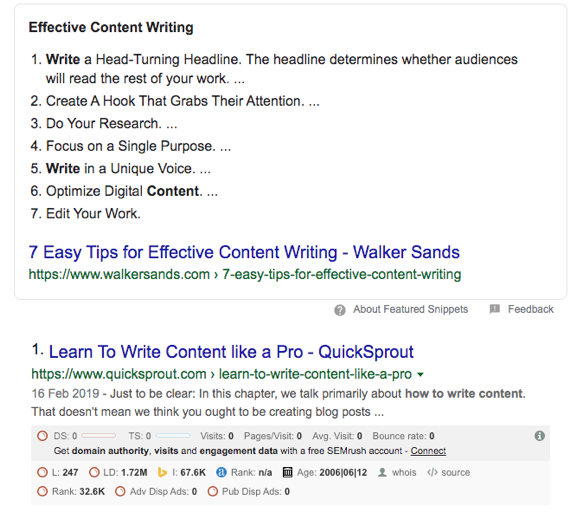
The robots haven’t taken over yet, but every day their ability to understand human behaviour, thought patterns and language is improving. The latter is especially relevant to content marketing and online content creators, as search engines use AI to determine the relevance of a search term or keyword to the contents of a web page. Google, in particular, has invested heavily in the machine learning of their search-engine robots, specifically in the areas of natural language processing (NLP), salience and neural matching.
Go here to read part one of this piece (it’s OK, we’ll wait) to get a fuller knowledge of these terms, but, to summarise, NLP involves the search-engine robot trying to understand the relationship and interactions between entities (keywords) and content; Salience is about matching a user’s search with the right results (website pages); and neural matching is how the robot finds a connection between vague or ambiguous search phrases and existing content online.
In part one we covered the way content should be created going forward and how writing for robots isn’t the death of unique, creative, human experience-led writing. Now let’s look at what content creators can do to adapt to search-engine AI, while still writing content that is ‘human’.
- Use an API to Understand Natural Language Processing
While content creators are likely not to be as advanced as Google in its uses for natural language processing, there are natural-language-processing APIs that can help you discover what the search-engine robot is extracting from a piece of content. Using these APIs enables you to get a clearer picture of how salient (or relevant) an entity (keyword) is to an article as a whole. Put simply, APIs allow you to see what a search-engine robot is pulling from a piece of content.

For example, when writing a recent search-engine optimisation article, I wasn’t sure if I should use ‘has’ or ‘have’ when referring to a company performing an action (i.e. Tesco has vs Tesco have… ) and – no smirking at the back – don’t act as if you haven’t been confused by such grammar usage, too. So, I headed to Google and searched ‘have or has company’. Now, the only way the robot can decipher what I’m on about is to go through web pages and extract keywords, phrases and content intent in order to contextualise/understand what it is I mean, so that it can serve me relevant results.
If you’re a content creator for a language or grammar website with a page that would have answered my query, you can run the page through an API to check whether the robot is picking up that your page relates to grammar and not ‘who has a company’ or ‘having company over for lunch’.
APIs give a score between 0 and 1. The closer you get to 1, the more a piece of content is seen as relating to the entity or keyword or search term entered. If your score is low, consider updating content to contextualise your topic further. Do this with your competitors’ pages, too, so you can discover what they are doing right to score high points.
2. Reduce Semantic Distance
Reduce the gap between the words that contextualise your piece of content. My go-to example for this is ‘Avatar’. If my content is about the movie, I make sure the entity ‘Avatar’ is close to entities such as ‘movies’, ‘films’, ‘James Cameron’, ‘box office’, ‘science fiction’, etc. This way, the robot (and therefore the human) knows I’m referring to a film rather than avatars for gaming consoles or social media platforms.
3. Answer the User’s Question Directly

If your content is aimed at answering a specific question in a topic or answering a question that requires a whole piece by itself, get right to it. Don’t tease the user with a waffling intro that forces the answer to end up midway through the article (scrolls up to check he hasn’t done exactly that). This doesn’t mean you have to get rid of introductions, my fellow content creators – you just need to shorten them or have keywords in the intro that relate to the question or give an answer right at the top, then break it down further on in the article.
If the question and answer will only be one component of a piece (such as ‘what is the best temperature to roast beef?’ in a roast beef recipe piece), answer the question succinctly. One way to make sure it stands out to the robot is to use the question as a bold header for a paragraph and then answer the question directly in the first sentence underneath it. This is good for users, too, because they can easily pick out the part of the content that relates to their specific question.
In addition, if you’ve ever done a question search on Google and seen the answer to your question appear right at the top in the results page, the likelihood is the content the robot is extracting it from has done exactly the above.
4. Write Short, Succinct Sentences
This is one I struggle with (which I hope you haven’t noticed), but it’s best to write simple sentences that hit the nail on the head of what you’re communicating. It’s said that one of the sins of writing is not trusting the reader. But as content creators, we often want to expand on a topic or an idea to make it understandable. This is not necessarily a bad thing and shouldn’t be mistaken for ‘only write short pieces’. On the contrary: search-engine optimisation research shows that in-depth content tends to rank better than shorter content. The suggestion here is just to be mindful of not over-complicating content, which can lead to contextual and user intent confusion.
Content writers can circumvent this paradox by starting off content by being specific or by summarising and then broadening or fleshing out the topic as you continue.
5. Use Headers, Bullet Points and Numbered Lists

This relates to points 3 and 4 above. Headings and subheadings have their own line of code, which emphasises their significance to the robot. The robot can extract headlines and use them as salience points to connect search entities to content. Optimise your headings so that they convey the context of your article and highlight keywords and search phrases relevant to what a user might search.
Bullet points and lists are especially good for relaying how-to information and writing succinct, short sentences, which contextualise content for humans and robots alike. Similar to question-led searches that generate answers right on the search-engine page itself, bullet points and lists will often pop up at the top of Google’s page (as in the screenshot below, where I searched ‘how to write content’) when a user does a certain type of search.

More often than not, the user will still click on the result to go to the website from which the result is generated and view the content in its entirety. It’s a win-win for man and machine.
6. Consider Where the User is on their Purchase Journey
Create your content with the user’s purchase journey stage in mind. Is the purchaser still at the beginning stage, just doing research to find out more about something? Or are they further ahead, perhaps at the comparison stage, figuring out which option is best? This should influence the information you present to the user. Approaching content creation this way will also assist Google’s AI in figuring out how much your content matches the user’s intent.

With each stage of the purchase journey having its own pain point, the keywords and phrases in a piece of content will help natural language processing and the neural matching used to determine the best cure (search-engine result) for the user’s pain point.
In conclusion, while content creators need to be aware of the importance Google has placed on writing content that allows the AI of its search-engine robot to decipher the context of content easily, this doesn’t mean you should stop or reduce the importance of writing with human users in mind. In Google’s own words (from their quality guidelines), website content creators should ‘make pages primarily for users’.
This means that what Google is really trying to achieve is for the robot to analyse content in a more intelligent, human way rather than guessing its relevance based on keywords used in a search query that also happen to be on a website page. By ‘thinking more human’, the robot can serve the most relevant content to the user. The factors mentioned in this post (natural language processing, salience and neural matching) can all be achieved when content is created to satisfy user intent, while also adhering to good SEO guidelines and Google’s own content best practices.



